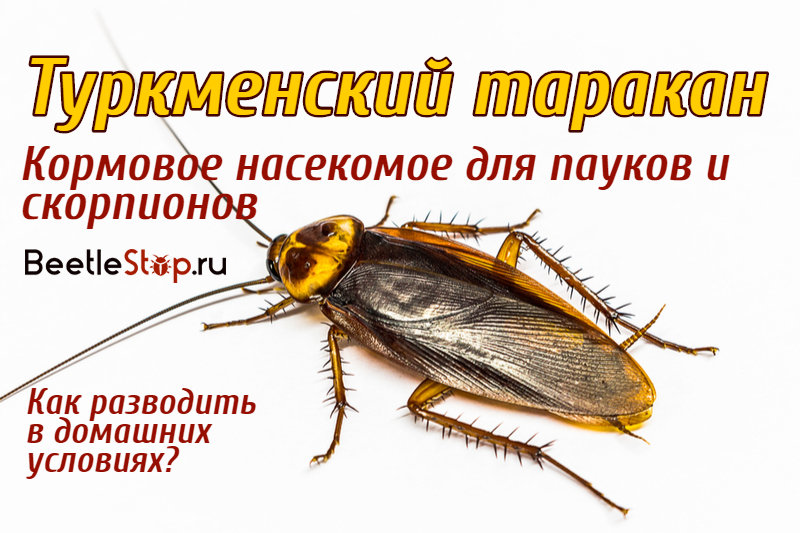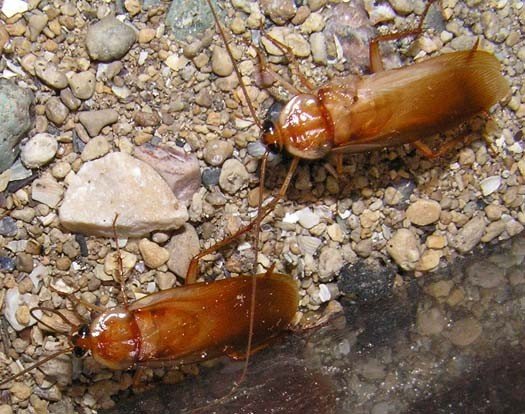How to breed a Turkmen cockroach? Description of the insect and optimal conditions
Turkmen cockroach (lat. Shelfordella tartara) is a medium-sized representative of the Tarakanovs detachment. He is best known for being bred at home as a future food for other pets: bunches, scorpions, hedgehogs. This is an unpretentious and easy to breed species, called “tartar” on the slang of breeders.

A brief introduction to the Turkmen cockroach
The size of adult individuals is from 2.5 to 3 cm. Males look larger than females because they have longer wings. In females, they are reduced, that is, they are in their infancy. Thanks to this feature, it is easy to determine the gender of the Turkmen cockroach.
Male tartars do not use their wings fully. But in case of danger, they bounce and begin to wave them, which gives the impression that the cockroach can fly.
There are other differences between males and females. In females, the color is dark brown, and on the edges of the elytra there is a strip of pale yellow color, and on the abdomen there are white-yellow spots. Males are lighter: red-brown with a golden tint. The color of the larvae is the same regardless of sex: the front of their body is orange, and the back is dark brown or black.

In the wild, Turkmen cockroaches live mainly in the south of Central Asia. Their population is great in the Ferghana Valley. Outside of Turkmenistan and Uzbekistan, they inhabit the territory of Saudi Arabia, Iraq and Iran, Kashmir (a region in the north-west of Hindustan). These insects are also found in Africa: throughout Egypt and in the northern part of Sudan. Tartars can usually be found under the stones. In natural habitats, they are often adjacent to humans, populating parks and even climbing into residential and utility buildings with clay floors.
Turkmen cockroaches in the house
The content of Turkmen cockroaches is very simple in comparison with the cultivation of other species at home. These are insects that are undemanding to conditions and nutrition. An important advantage is their inability to crawl on a glass and other smooth surface, so the likelihood of escape from the cage is reduced.
According to the recommendations for keeping Turkmen cockroaches at home, the species is similar to marble cockroach. But the important difference between these types is that the tartars can “take root” in the apartment in case of escape, so their owner must be careful.
Their breeding is beneficial, because it requires minimal costs with excellent fecundity of individuals.
Conditions
Arranging a suitable "home" for cockroaches does not take much time and money. In its quality, an old aquarium or an ordinary container made of plastic is suitable, in which holes must be made to ensure the influx of fresh air.
Other requirements for the maintenance of the Turkmen cockroach:
- For the life of the insect, it is not necessary to pour a substrate at the bottom of the cage. Litter is needed only for laying eggs by females. But all cockroaches need shelters that mimic secluded places in their natural habitat.To do this, use a disinfected bark of trees (calcined in the oven or scalded with boiling water) or cellular egg trays (a more affordable option).
- In the cage, a bowl with food and a drinker is required, because cockroaches often eat and drink. For successful growth and reproduction, they need constant access to food and fluids.
- Cockroaches are thermophilic creatures. Therefore, the optimum temperature for the propagation of tartars is 27–30 ° C. If it is indoor, then, according to observations, the population develops more slowly.
- In nature, the Turkmen cockroach lives in a dry climate, and no spraying of the cage is required. Suitable air humidity is about 60%.
Be sure to cover the cage so that cockroaches do not run away. Although they do not crawl on glass and smooth walls, some individuals exhibit excellent jumping ability. Therefore, tartars are able to escape and continue breeding in the apartment.
Food
For feeding a Turkmen cockroach use:
- vegetables and fruits;
- dry food for aquarium fish, cats and dogs (loose or in the form of small granules);
- cereals;
- dried young oak leaves;
- finely chopped dandelion greens.
Thanks to such taste preferences, the cultivation of Turkmen cockroaches does not require large cash costs.
Taratras never eat their relatives and skins left after molting. Because of this, ticks may appear in the cage or an allergic reaction to the owner. Therefore, the insectarium needs to be cleaned regularly.
Cockroaches are not recommended to give bananas, cabbage and tomatoes. Eating them impairs the taste of the insect, which is unfavorable when grown as feed.
Breeding
Under favorable conditions, cockroaches begin quickly multiply. Soon after mating, the females lay their eggs in a cocoon. Such a “design” is called an ootec. A cockroach attaches it to a substrate or hides it in shelters. Young individuals appear after 1–1.5 months. The full cycle of development of an insect before maturity is about 5 months. The life expectancy of an adult cockroach is 3-5 months: they spend all this time in continuous reproduction.
It is recommended to line the bottom of the cage with moss, so that it is convenient for the females to lay down the ooteks. Of great importance is the air temperature: if it is below 27 ° C, then the maturation of the eggs will be slower. The cockroaches that have just emerged from the eggs adapt for the first few days and eat nothing.
Turkmen cockroach, grown as a feed insect, will not cause much trouble. It is enough to provide him with simple living conditions and suitable nutrition.


I do not agree that Turkmen cockroaches will take root in the apartment. 1. Need a higher temperature 2. They do not tolerate humidity and drink a lot, there is no such place, the bathroom is cool and humid. So the conditions are not suitable. 3. I had shoots, after a while I found (sometimes) dead. In general, young cockroaches did not appear. The first escape took place more than a year ago, so we could have taken root.
I do not agree that they do not eat their relatives, I was a witness of cannibalism on the part of young individuals.
They run in droves, but they also hatch in the same way. Young also never watched.
Cockroaches lived with me 7 months ago, sheared the swifts ... the swifts flew away safely in August, and yesterday (March) they came across a hefty Turkman in the bathroom ... Either one of my fugitives survived, or someone in the house was hunting cockroaches